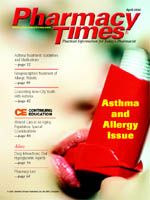Publication
Article
Pharmacy Times
Counseling Inner-City Youth with Asthma
Author(s):
Due to asthma, 13.7 million American adults and 6.3 million children periodically gasp for air. With approximately 1 in 13 school-age children affected?an increase of 72.3% since the 1980s?asthma-related absenteeism amounted to 14 million school days in 2000. The 3 million Emergency Department (ED) visits, 500,00 hospitalizations, and 6000 deaths cost $12.4 billion annually.1-3 Affected disproportionately, African American children with asthma are 2.3 times more likely to visit an ED, 3.8 times more likely to be hospitalized, and 2 to 3 times more likely to curtail activities.4 Proper medication technique, prevention efforts, addressing unique circumstances of school-age sufferers, and understanding inner-city life's challenges are critical for successful outcomes.
Inner-City Challenges
Inner cities teem with asthma-causing agents: tobacco and cooking smoke, indoor allergens, bioaerosols and other air pollutants, respiratory infections, and stress. Indoors approximately 90% of the time, up to 59% of inner-city pediatric asthma sufferers live in homes with environmental tobacco smoke. Sensitivity to allergens is typical of pediatric asthma. Most inner-city children (94%) are highly sensitive to inhalant allergens, and 76% are sensitive to 3 or more allergens. Approximately 36% have cockroach sensitization. Combining cockroach (but not mouse, dust mite, or cat) allergen sensitization with regular exposure significantly increases asthma-related hospitalizations, Emergency Room visits, school absenteeism, and lost sleep.4,5
Adherence: A Problem
Too frequently, nonadherence to asthma-medication regimens leads to severe exacerbations. One study of near-fatal asthma attacks found that, despite adequate self-management knowledge, only 29% of patients used systemic corticosteroids, although 62% had symptoms exceeding 48 hours.2
Patients overreport adherence: one study found that patients reported almost complete adherence, but actual inhaled corticosteroid use was only 58%. Despite clinical need, inhaled corticosteroid use hovers around 14%.4 With 50% of children under age 9 responsible for their own medications,6 most use asthma medications inappropriately and employ ineffective inhaler techniques. Approximately one third exceed prescribed doses or discontinue medication prematurely.7
Causes of Nonadherence
Understanding causes of nonadherence helps structure counseling. Significant barriers are created by parental health beliefs (eg, 89% resort to some form of complementary/ alternative treatment8), the use of multiple care providers, the lack of a comprehensive asthma-management plan, psychosocial stressors, inadequate attention to triggers and early warning signals, and inadequate environmental allergen control. Many schools have a zero-tolerance drug policy; students may smuggle and take their asthma medications discreetly, or they may leave their medications at home. Asthma sufferers in the throes of adolescence often forget their inhalers when leaving the house, feel anxious or embarrassed or secretive about their asthma, and may not know what medication they are taking.4,9 The media sometimes mislead people. Some youths equate all steroids, and they shy away from inhalers after hearing about weight lifters who take steroids. Others see advertisements recruiting people into class action litigation against asthma-drug manufacturers, and they discontinue use.2,4 Effective counseling must address media distortion and must educate patients with facts and fine points.
Treatment
National asthma treatment guidelines recommend a staging pharmacotherapy. The Table summarizes the guidelines. More information is available for pharmacists by visiting www.nhlbi.nih.gov/guidelines/asthma/asthsumm.htm. Effective treatment depends on a comprehensive asthma-management plan. A care plan must go beyond long-acting (controlling) and prn (rescue) medications and incorporate patient education concerning asthma triggers and controlling environmental stressors. The National Heart, Lung and Blood Institute (NHLBI) publishes 2 excellent patient brochures on controlling asthma. They can be found at www.nhlbi.nih.gov/health/public/lung/index.htm. Treatment staging is guided by a "medical traffic light"?with a green zone (symptom remission), a yellow zone (mild worsening of symptoms), and a red zone (medical alert requiring immediate professional intervention). To minimize subjectivity, peak-flow meter readings anchor the 3 stages. The NHLBI recommends that asthma sufferers over the age of 4 with moderate-to-severe asthma should use a peak-flow meter daily.
Counseling
Counseling the patients with asthma starts with information gathering. Ask whether the patient uses a peak-flow meter, and discuss peak-flow values. Also, inquire whether the patient's school allows self-medication. Ask if the youth self-medicates, and if other people care for the child during the day. Involve all parties responsible for medication. Listen, and reply to the patient (not the parent) in simple language.
Focus on medication, differentiating long-term-control medications (taken daily over an extended period of time to achieve and maintain control of persistent asthma) and quick-relief medications (which promptly reverse acute breathing difficulty). Stress that both types of medication often are needed. Patients must know how to use inhalers properly, and inhalers and nebulizers can be difficult to use. Some require insertion into the mouth; others are held 1 or 2 inches from the face. Pharmacists should physically demonstrate with each new prescription and offer review at refill. Always review the dose, and counsel patients on the canister's capacity.
Concerning prn medications, discourage any delay when symptoms start, and remind the patient to carry an inhaler at all times. Emphasize the importance of talking to the school nurse about the condition before an attack occurs. Finally, dispel medication myths if necessary.
Nonmedication Issues
Nonmedication issues include environmental control. Cockroach infestation is a touchy subject. Point out that hot water is more effective than cold water for washing bed linens. Recommend a smoke-free environment. Explain how keeping a diary helps to identify triggers. Ideally, counseling should be reinforced with patient brochures. Counseling always should conclude with encouraging patients to ask questions and with the statement, "If you have additional questions later, please don't hesitate to give us a call. We are happy to help."
For a list of references, send a stamped, self-addressed envelope to: References Department, Attn. D. Ryan, Pharmacy Times, 241 Forsgate Drive, Jamesburg, NJ 08831; or send an e-mail request to: [email protected].

Newsletter
Stay informed on drug updates, treatment guidelines, and pharmacy practice trends—subscribe to Pharmacy Times for weekly clinical insights.






